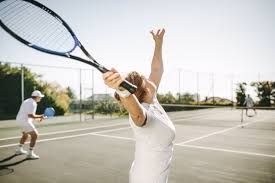
Exploring The Top Tennis Injuries and How to Prevent Them
Exploring The Top Tennis Injuries and How to Prevent Them
Playing tennis is a great way to stay active and enjoy yourself at the same time. It uses every part of your body, and it’s definitely more socially engaging than a HIIT video at home and certainly more high energy than hitting the treadmill at the gym. But like any athletic endeavor, tennis requires proper stretching, technique, and attention to form in order to avoid injuries.
Here are a few of the most common tennis-related injuries and how you can best avoid them:
Rotator Cuff Injuries
A rotator cuff injury – which affects the tendons and muscles that rotate and stabilize your shoulder – can happen suddenly or gradually over time. Overusing the rotator cuff by swinging a tennis racket again and again can cause a rotator cuff tear.
You can help prevent this injury by doing stretches and exercises intended to strengthen the muscles that make up the rotator cuff. These stretches can usually be done at home, at work, or as part of your warm up before you start your game.
Wrist Tendonitis
You may develop inflammation of the tendons in the wrist over time from swinging your racket, especially if you’re using excessive wrist motion with each swing. If you have tendonitis in your wrist, you may feel pain on either side of the wrist or in the palm, or you may hear a clicking in your wrist.
You can help prevent this injury by working with a tennis instructor to improve your technique. Using the right racket will also help. Correct grip size, string tension, racket size, and weight will help prevent wrist strain when you swing your racket.
Ankle Sprains
The fast-paced action of the game makes ankle sprains a real possibility. Whether you roll your ankle or tweak it in a quick change of direction, you may pull ligaments that create a sprain.
You can help prevent this injury by wearing padded tennis socks or two pairs of regular socks. You should also make sure your athletic shoes provide good support and replace them right away when they get worn out.
Stress Fractures in the Back
A broken back sounds severe, but stress fractures are not always painful. You may only experience lower back pain that gradually worsens, especially when playing tennis or other sports. The extension movements required to serve the ball and to bend and rotate as you play can put undue stress on your spine.
You can help prevent this injury by working with a tennis instructor to learn how to serve the ball without arching your back too much and how to balance your body weight by bending your knees and raising your heels. Back strengthening exercises and stretches also keep your back limber and strong.
Jumper’s Knee
For most people, jumping is just a routine part of playing tennis. But this can cause microscopic tears or put strain on the patellar tendon, which attaches the kneecap to the shinbone, causing jumper’s knee.
You can help prevent this injury by avoiding overexertion. Rather than doing only high-impact sports, which may eventually wear out the cartilage in your knees, make it a point to vary your routine to incorporate low-impact activities like walking, swimming, strength training, and yoga.
Tennis Elbow
Inflammation of the tendons joining the forearm muscles to the outside of the elbow – called tennis elbow – is a repetitive motion injury caused by swinging your tennis racket over and over. It can cause pain or burning on the outside of the elbow and may weaken your grip.
You can help prevent this injury by using the right racket. Ask a tennis professional to help pick one that’s right for you. Working with a tennis instructor to improve your technique will also help prevent tennis elbow.
As with any exercise regimen, you should talk to your doctor before getting started. If you’re concerned about how your body may respond to playing tennis – or if you’re experiencing some physical impacts of tennis already – you may want to visit an orthopaedic specialist.
Dr. Russell Ellis of DOC Orthopaedics and Sports Medicine specializes in rehabilitation and non-surgical treatment of sports-related injuries. His goal is to provide ongoing medical treatment and guidance for athletes to recover quickly and fully from sports-related injuries and avoid surgical solutions whenever possible.
Raised in Morgan County, Dr. Ellis is a graduate of Danville High School and a magna cum laude graduate of the University of Alabama, where he was inducted into Phi Beta Kappa, the oldest and most prestigious academic honor society in the United States. He received his Doctor of Medicine degree from the University of Alabama School of Medicine at Birmingham and completed his residency at the University of Tennessee College of Medicine at Chattanooga in the field of Physical Medicine and Rehabilitation, serving as Chief Resident his final year.
After residency, Dr. Ellis spent an additional year as a Sports Medicine Fellow at the American Sports Medicine Institute in Birmingham and trained under Dr. Tracy Ray and renowned sports medicine physician, Dr. James Andrews. He currently serves as team physician for several area high schools and Calhoun Community College. He has a current Clinical Faculty appointment for the Alabama College of Osteopathic Medicine and has served as an Oral Board examiner for the American Board of Physical Medicine and Rehabilitation. Dr. Ellis and his wife have been blessed with three children and are glad to call the north Alabama area home.
Reach out to Dr. Ellis and the rest of the team of sports medicine pros at DOC Orthopaedics and Sports Medicine by calling 256-350-0362.

